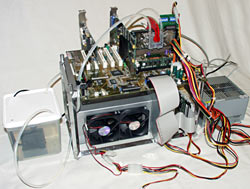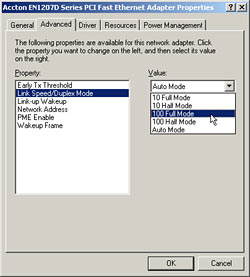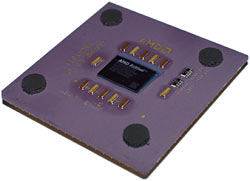
Atomic I/O letters column #2
Originally published in Atomic: Maximum Power Computing Reprinted here 17-Apr-2002.Last modified 16-Jan-2015.
Toasty chips
Does the room temperature have any effect on CPU temperature? My CPU temp is 55 degrees C in the morning when the room temp is about 20 degrees, and 63 degrees when the room temperature is 25 degrees.
Ricko
Answer:
Yes, ambient temperature affects CPU temperature. In a normal computer with
an ordinary heat sink and fan on the CPU, it's a pretty simple relationship.
Air's moved through the case by the power supply fan and any other throughflow fans that are installed. That air flow, and the amount of heat produced by all of the stuff in the computer, determine the temperature of the air inside the case, and it's that inside air that's used to cool the CPU. The hotter the air outside the case, the hotter the air inside the case, and the hotter the CPU.
Given all the variables in computer case cooling - variations in CPU heat output, other heat sources, "heat soak" through the case, not to mention calibration errors in the CPU temperature monitor and whatever you use to measure the ambient air temperature - your results aren't at all peculiar.
Cooling system design is an exact science, but amateur PC cooling usually isn't. There's no point spending days to get maximum efficiency out of a cooling system when you can easily just provide a lot more cooling than the system needs...
...and have an overpowered but very effective solution.
(The above monstrosity is from my old water cooling piece here, by the way.)
Faster, damn you, faster!
I have an unlocked Duron 650 and an Asus A7V motherboard, 128Mb PC133 Apacer RAM and a Thermoengine cooler. Every time I overclock it on the multiplier to 750MHz I get heaps of registry errors on Windows ME and 2000, or my computer just crashes while loading.
I've installed Windows again, but I still get the same thing happening. I've tried upping the Vcore as suggested, but still no good.
I've heard people are getting this CPU to around 850-900MHz stable. I would like to achieve something around 800-850 without buying new stuff.
Edwin HYD Cheng
Answer:
How far you can overclock a given processor depends mainly on that one CPU's
core capabilities. The motherboard and RAM and other components can come
into it, especially when you're playing around with Front Side Bus overclocking,
but it's mainly down to the CPU.
I get lots of these sorts of letters, from people who are irked that their processor isn't as overclock-friendly as various other CPUs they've heard of, about which dead Vikings in Valhalla, or possibly even dead Klingons in Sto-Vo-Kor, can reasonably be expected to sing songs.
Essentially, you have to remember that if every 650MHz Duron could do 800MHz with adequate cooling, then they'd be sold with a big cooler and an 800MHz sticker. If you just assume that any CPU you buy isn't going to be good for more than a ten per cent overclock (which you really can do with just about any processor), then anything else you manage to get out of it will be a pleasant surprise.
650MHz Durons can indeed often run at 800MHz or more. If you've got one that doesn't want to play much above 700MHz, though, then, well, c'est la vie.
The White Box Mystery
What does it mean when people are selling "OEM" software and hardware? What is "OEM"?
Richard Liu
Answer:
OEM stands for Original Equipment Manufacturer. And, as Wikipedia currently
says, it is indeed "an ambiguous and
abstruse phrase".
In computer-gear parlance, an "OEM version" is a product that's meant to be sold to system assemblers, and which comes in a white box (if it has a box at all!), and has no fancy software bundle.
OEM is also used to indicate when one company makes gear that will be badged with someone else's brand. One factory may make the same MP3 player, computer case or external drive box for several brands in different countries - or even in the same country. In this case you can use OEM as a verb - "this router was OEMed for D-Link by Krap-E Network Supplies of Taiwan".
Retail shoppers will usually only encounter the "white box" kind of OEM gear, which often won't have any brand on it at all.
An OEM CPU, for instance, is one that comes in a tray with lots of other CPUs, and which has nothing else included. Anything you get with it if you buy it retail, right down to the anti-static bag, is added by the retailer.
An OEM sound or video card may come in a white box, or may just come in an anti-static bag. OEM expansion cards usually have a driver CD with them, but that's all.
Occasionally, OEM versions of graphics cards are lower-spec than the retail version (less memory, lower clock speed, or both), but often they're precisely the same thing, with less packaging. I don't think you'll often find OEM versions of high-end graphics cards, though.
Some OEM gear is sold under contractual agreements that say it's not to be sold on, except to someone assembling a computer. That's the deal with those OEM white-box copies of Windows which you're only meant to be able to buy along with a CPU, motherboard and hard drive.
Most OEM gear, particularly hardware, is just the totally-no-frills version of the product, though, and it's perfectly legit for people to sell it retail. OEM parts can be a very good deal.
Duplex trouble
I have several machines at home that I have set up into a network. Three computers, one 10BaseT hub. It works fairly well but I have some problems. Namely, the network cards can do "full duplex", but it is way slower than standard mode, with or without the hub (I have a crossover cable too). Can you tell me about this?
Also, one of the machines has an Internet connection, and I would like to have the connection available to all of the machines on the network. How do I go about this?
Matt Coombe
Answer:
10BaseT and 100BaseT Ethernet uses two cable pairs, each of which can carry
one signal. In normal "half duplex" mode, data can flow either way, but
only one way at a time. It's like people communicating with walkie-talkies.
In half duplex mode, the second cable pair's used for collision signalling. When two computers are trying to send data at the same time, the signal that tells them about the problem is sent on the second cable pair. When they hear that signal they both stop, pause for a brief random period of time, then try again. The random pause means they probably won't collide again, and it's all done automatically by the network cards themselves; the rest of the computer doesn't have to involve itself.
In full duplex mode, both cable pairs are used for data, with one pair for each direction. This only works for two computers, or for computers that are connected directly to a port on a switch, not a hub.
Switches "segment the collision domain", and don't let things on their different ports talk over each other. Hubs just repeat everything they hear on one port to every other port. My networking guide here explains the difference in more detail.
If you use full duplex when you shouldn't, there's no collision detection and loss of data due to collisions has to be detected by higher-up network protocols. They take much longer to notice and request a resend, and that's why you lose a ton of network performance.
Full duplex, though, should work over your crossover cable. Only two computers, after all. If one or both of the network cards isn't doing it properly - and some cards don't - then that'd explain the problem.
Since most network transactions are very asymmetric - one side does almost all the talking - duplex makes little difference for home and small office purposes. So don't worry about it.
If you want to share your Internet connection, the easiest way is with Network Address Translation (NAT) software, such as the Internet Connection Sharing (ICS) that comes with Windows 98 Second Edition and later versions of Windows (WinME, Win2000). If you don't have one of those versions of Windows, there are many other hardware and software options; I talk about a few of them here.
Picking a processor
I'm shopping for a new computer, but I don't know what CPU to get. Price isn't a big concern; I just want a CPU that'll be good for games and won't be outdated too quickly.
I read that the Athalon has a better FPU than the Pentium III, but the P-III's a better overclocker. What's better, Athalon or P-III?
Ben Chan
Answer:
Athlon! Athlon! Athlon!
There is no "Athalon"!
Add syllables to things and you sound like a twelve-toed porch-squattin' banjo-picker!
Grr!
Ahem.
When I first wrote this column for Atomic magazine, the 1.33GHz Thunderbird Athlon had only recently been released to the Australian market, and the faster Athlons were obviously the CPU to choose for a new system. The P-III wasn't even in the running. A 1.13GHz P-III was the fastest you could get, but even the cheaper 1GHz P-III cost about as much as the roughly 40% faster 1.33GHz Athlon.
Now that I put this column up on the Web, the P-III's pretty much a niche product, and current Palomino Athlons (and the upcoming Thoroughbreds) are up against Pentium 4s. When the P4 was young, it was lousy value for money for various reasons; now RDRAM is far cheaper, and Socket 478 has replaced the original Socket 423, and P4 motherboards that use DDR memory are all over the place, and the price of the P4 chips themselves isn't as ridiculous compared with Athlon pricing.
But the Athlon's still better value.
Athlons are faster than P-IIIs at a given clock speed, much faster than P4s at a given clock speed (hence AMD's "PR rating" model numbering, which lines the slower-clocked AMD chips up against the P4s they actually perform like, no matter how often AMD insist that's not what the number means). And Athlon systems are still cheaper for a given performance level, though the difference isn't nearly as big as it was.
It used to be Athlon first, Duron second if you want a bargain system, daylight third; now the P4's, arguably, a pretty close second, depending on how much you have to spend.
If you want to upgrade an existing machine without changing the motherboard then it's a different story. But for a new system, get an Athlon.
Techno-perv
Is there really a camcorder that can see through clothes? Where can you buy one?
Gird Thomas
Answer:
Sigh.
Some image-sensing technologies are sensitive to near infrared (IR) light. The charge-coupled devices (CCDs) used in most digital cameras and camcorders, for instance, all are. Most digital cameras and camcorders will see the IR light emitting diode (LED) of a remote control as a bright white dot.
Anything that's illuminated with near infrared will therefore be visible to a CCD. And if there's no visible light illumination, it won't be visible to the naked eye.
Many better camcorders and digital still cameras have IR filters installed, to stop IR detection from happening, so you don't get exposure problems. It's the same reason you put UV filters on plain film cameras; the non-visible light otherwise hazes the picture. Ordinary film is UV sensitive, not IR sensitive - for IR sensitivity you have to buy special film.
Sony, famously, made a camcorder (the TRV99) with a switchable IR filter, and an IR illuminator. It let you see in the dark. It also let you switch out the IR-blocking filter in the day time. If you then put a filter over the lens that passed nothing but IR, you could see an odd black and white view of nothing but the near-IR kindly provided for you by the world's best IR illuminator, the sun.
And yes, some textiles are fairly transparent to near IR, and so pervs could use that camcorder to see through clothes. After a fashion.
Ever since the Sony camera hit the market - and was then withdrawn, because of unfortunate publicity - every dirty-raincoat dimwit has been bothering camera store staff for IR filters for other cameras, which let through IR and block pretty much everything else. They're under the impression that this is the for-real version of the X-Ray Specs advertised on the back of comic books.
The store staff sell 'em the filters, all right, because they know that J. Random Pervert isn't going to come back and ask for a refund 'cos he couldn't see all them Catholic schoolgirls in the nuddy like he wanted to.
IR filters do, indeed, let you get rid of visible light pollution when you actually want to see nothing but IR. But they're specialised gizmoes, and practically useless for ordinary subjects. Not least because almost all clothing is thoroughly opaque to near IR.
It's ever so much cheaper to just imagine people naked.




